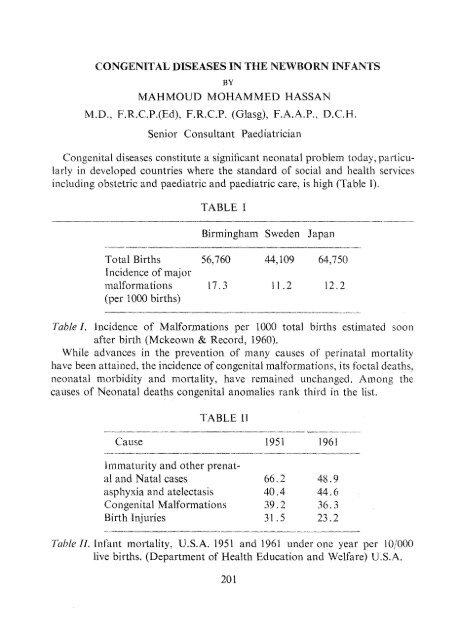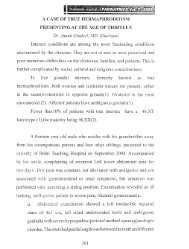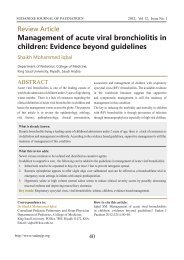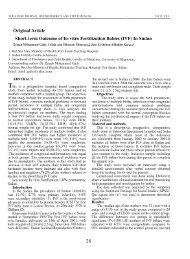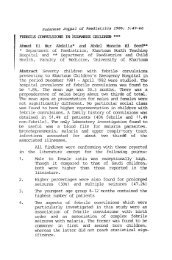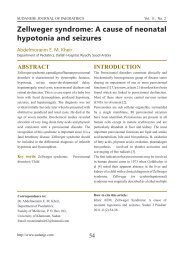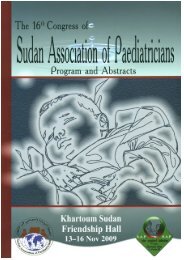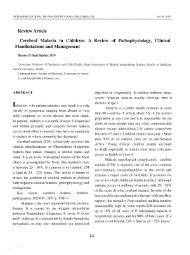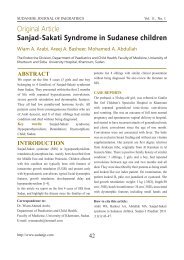Congenital diseases in the newborn infants - Sudanjp.org
Congenital diseases in the newborn infants - Sudanjp.org
Congenital diseases in the newborn infants - Sudanjp.org
Create successful ePaper yourself
Turn your PDF publications into a flip-book with our unique Google optimized e-Paper software.
CONGENITAL nISEASES IN THE NEWBORN INFANTSBYMAHMOUD MOHAMMED HASSANM.D., F.R.C.P.(Ed), F.R.C.P. (Glasg), F.A.A.P., D.C.H.Senior Consultant Paediatrician<strong>Congenital</strong> <strong>diseases</strong> constitute a significant neonatal problem today, particularly<strong>in</strong> developed countries where <strong>the</strong> standard of social and health services<strong>in</strong>clud<strong>in</strong>g obstetric and paediatric and paediatric care, is high (Table I).TABLEITotal Births 56,760Incidence of majormalformations 17.3(per 1000 births)---------"---Birm<strong>in</strong>gham Sweden Japan44,109 64,75011.2 12.2Table I. Incidence of Malformations per 1000 total births estimated soonafter birth (Mckeown & Record, 1960).While advances <strong>in</strong> <strong>the</strong> prevention of many causes of per<strong>in</strong>atal mortalityhave been atta<strong>in</strong>ed, <strong>the</strong> <strong>in</strong>cidence of congenital malformations, its foetal deaths,neonatal morbidity and mortality, have rema<strong>in</strong>ed unchanged. Among <strong>the</strong>causes of Neonatal deaths congenital anomalies rank third <strong>in</strong> <strong>the</strong> list.TABLEIICause1951 1961Immaturity and o<strong>the</strong>r prenataland Natal casesasphyxia and atelectasis<strong>Congenital</strong> MalformationsBirth Injuries66.240.439.231.548.944.636.323.2Table II. Infant mortality, U.S.A. 1951 and 1961 under one year per 10/000live births. (Department of Health Education and Welfare) U.S.A.201
Many congenital malformations are <strong>in</strong>compatible with extrauter<strong>in</strong>e lifeand consequently <strong>the</strong>ir <strong>in</strong>cidence <strong>in</strong> still birth is high. Among 5739 products ofconception weigh<strong>in</strong>g over 500 Gm., McInotsh and co-workers (J 954) foundthat congenital malformations constitute an important cause of still births andneonatal deaths (Table III).TABLE---_._---------Over-all <strong>in</strong>cidence of malformations7.5%Incidence among antepartum deaths13.6%Incidence among <strong>in</strong>trapartum deaths 23.3%Incidence among Neonatal deaths.29.6%Table III Incidence of congenital malformations (McInotsh, 1954).There are many types of congenital <strong>diseases</strong> which are now compatible withlife ow<strong>in</strong>g to <strong>the</strong> recent progress <strong>in</strong> surgery, anaes<strong>the</strong>sia, biochemistry andantibiotics.In <strong>the</strong> Sudan, although <strong>in</strong>fectious <strong>diseases</strong> and malnuitrition still rema<strong>in</strong><strong>the</strong> most major Paediatric problems, congenital <strong>diseases</strong> are ga<strong>in</strong><strong>in</strong>g significanceow<strong>in</strong>g to <strong>in</strong>creas<strong>in</strong>g awareness of <strong>the</strong> problem, its methods of prevention andtreatment. Accurate vital statistics about <strong>the</strong> <strong>in</strong>cidence of congenital malformationscannot yet be obta<strong>in</strong>ed, but our cl<strong>in</strong>ical impression, judg<strong>in</strong>g from <strong>the</strong>large number <strong>in</strong> our records, <strong>in</strong>dicates that <strong>the</strong>y are uncommon. Some rarecongenital <strong>diseases</strong> such as Morquio's disease have a strik<strong>in</strong>gly high <strong>in</strong>cidence<strong>in</strong> <strong>the</strong> Sudan. The common practice of consangu<strong>in</strong>ity is of particular geneticsignificance as an aetiological factor.This paper will discuss <strong>the</strong> most common congenital <strong>diseases</strong> encountered<strong>in</strong> Sudanese <strong>newborn</strong> <strong>in</strong>fants.Classification :-(J)<strong>Congenital</strong> skeletal <strong>diseases</strong>:1. Osteogenesis Imperfecta,2. <strong>Congenital</strong> malformations of <strong>the</strong> Extremeties:(a) Phocomelia.(b) Syndactyly.(c) Polydactyly.(d) MacrodacIyJy.3. Achordroplasia.4. Gargoylism.202HI
5. Sacro-coccygeal agenesis.6. Craniosynostosis.(a) Craniofacial dysostosis (Crouzon's disease)(b) Scaphocephaly.(2) <strong>Congenital</strong> <strong>diseases</strong> of <strong>the</strong> muscles1. Arthrogyposis multiple,l. <strong>Congenital</strong> absence of abdom<strong>in</strong>al muscles.(3) Inborn Errors of metabolism1. Phenylketonuria.2. Galactocaemia.(4) <strong>Congenital</strong> <strong>diseases</strong> of <strong>the</strong> Nervous System1. Rubella syndrome.2. Mongolism.3. <strong>Congenital</strong> hydrocephalus.4. <strong>Congenital</strong> amyotonia.5. Sp<strong>in</strong>a B<strong>in</strong>da.(5) <strong>Congenital</strong> Endocr<strong>in</strong>e DiseasesCret<strong>in</strong>ism.(6) <strong>Congenital</strong> Heart Diseases:1. Transposition of <strong>the</strong> vesseis.2. Coarctation of <strong>the</strong> aorta.3. Aortic atresia.4. Pulmonary atresia.5. Tetralogy of Fallot.6. Ventricular Septal Defect.7. Dextrocardia.(7) <strong>Congenital</strong> Blood Diseases1. Haemolytic Diseases of <strong>the</strong> Newborn2. Glucose-c-Phosphate Dehydrogenase Deficiency.3. Haemophilia.(8) <strong>Congenital</strong> Diseases of <strong>the</strong> Lymphatic System1. <strong>Congenital</strong> Lymphoedema (Milroy's Disease)(9) <strong>Congenital</strong> Disease of <strong>the</strong> Respiratory System1. Choanal atresia.203
2. <strong>Congenital</strong> Laryngeal Stenosis.3. Diaphragamatic Hermia.(10) <strong>Congenital</strong> Diseases of <strong>the</strong> Digestive SystemI. Hare-lip and cleft-palate.2. Micrognathic.3. Duodenal atresia.4. <strong>Congenital</strong> Pyloric Stenosis.5. Malrotation of <strong>the</strong> gut.6. Hirschsprung's Disease.7. Imperforate anus and rectal atresia.(J I) <strong>Congenital</strong> Diseases of <strong>the</strong> liver and hile.I. Glycogen disease.2. <strong>Congenital</strong> atresia of <strong>the</strong> bile ducts.(12) <strong>Congenital</strong> Diseases of <strong>the</strong> Sk<strong>in</strong>.I. <strong>Congenital</strong> Icthyosis.2. <strong>Congenital</strong> Syphilis.3. Alb<strong>in</strong>ism.Cl<strong>in</strong>ical Manifestation <strong>in</strong> <strong>the</strong> Newborn Infant.(I) <strong>Congenital</strong> SkeletalDiseases.J. Osteogenesis ImpefectaThis is <strong>the</strong> <strong>in</strong>trauter<strong>in</strong>e type of <strong>the</strong> disease, which manifest <strong>in</strong> <strong>the</strong> <strong>newborn</strong>by extremely th<strong>in</strong> cranial bones and generalized multiple fractures. The scleraehave strik<strong>in</strong>gly blue appearance. It is def<strong>in</strong>itely hereditary, but <strong>the</strong>re is considerablevariation <strong>in</strong> <strong>the</strong> degrees of penetrance, Some familities showed a dom<strong>in</strong>antgenetic defect.Most <strong>in</strong>fants die <strong>in</strong> utero, dur<strong>in</strong>g delivery or soon after. Subarachnoidhaemorrhages seem to be <strong>the</strong> immediate cause of death.(2) <strong>Congenital</strong> Malformations of <strong>the</strong> Extremeties.(a) Phocomelia. - i.e. great reduction <strong>in</strong> size of proximal parts of <strong>the</strong> limbmay be of genetic orig<strong>in</strong>. The thalidomide tragedy resulted <strong>in</strong> a large numberof phocomeliae of <strong>the</strong> upper limbs <strong>in</strong> Europe. This tranquilliz<strong>in</strong>g drug givendur<strong>in</strong>g <strong>the</strong> early weeks of pregnancy, <strong>the</strong> most dangerous period was between28 to 42nd. day of onset of pregnancy. O<strong>the</strong>r congenital anomalies <strong>in</strong>cludedatresia or stenosis of oesophagus and duodenum.(b) Syndactyly, Polydactyly and Macrodactyly can occur alone or <strong>in</strong> associationwith o<strong>the</strong>r congenital malformations.204
(3) AchondroplasiaThe disease is hereditary, which may be dom<strong>in</strong>ant or recessive. The defect<strong>in</strong>volves ossification of cartilage and leads to shorten<strong>in</strong>g of limbs. It can bediagnosed by an antenatal radiological picture. At births <strong>the</strong> cl<strong>in</strong>ical pictureof short limbs and <strong>the</strong> relatively large head is diagnostic. The majority of casesare ei<strong>the</strong>r still-born or die soon after birth.(4) Gargoylism. (Chondro-Osteo -- dystrophy)This is a familial disease, and if one baby is affected <strong>in</strong> a family, <strong>the</strong> recognitionof ano<strong>the</strong>r similarly affected new-born <strong>in</strong>fant becomes possible. The fullydeveloped manifestations of hepatosplenamegaly, mental retardation, kyphosis,dwarfism, corneal cloud<strong>in</strong>ess appear later. The disorder is geneticallydeterm<strong>in</strong>ed be<strong>in</strong>g caused by an autosomal recessive disease. The basic metabolicdisturbances is now known to be <strong>in</strong>tracellular shortage of mucopolysaccharide,which can be found <strong>in</strong> <strong>the</strong> ur<strong>in</strong>e <strong>in</strong> high concentration from birth.In a family under my care <strong>the</strong> first-born <strong>in</strong>fant was affected. The follow<strong>in</strong>gtwo pregnancies occurred <strong>in</strong> United States where <strong>the</strong> fa<strong>the</strong>r was work<strong>in</strong>g <strong>in</strong><strong>the</strong> Sudan Embassy. Am<strong>in</strong>ocentesis was carried out <strong>the</strong>re at <strong>the</strong> 4th. month ofpregnancy and correct diagnosis of <strong>the</strong> second affected baby and a thi rd normalnew-born was achieved at each occasion.(5) Sacra-coccygeal agenesis.<strong>Congenital</strong> absence of <strong>the</strong> Sacrum has a characteristic physical appearance,which is lack of prom<strong>in</strong>ence of <strong>the</strong> buttocks with absence ofa groove between<strong>the</strong>m. X-ray shows absence of sacral and coccygeal bones. The defect is notfamilial.(6) Craniosynostosis.<strong>Congenital</strong> premature closure of cranial sutures leads to deformity of headand may cause damage to <strong>the</strong> bra<strong>in</strong> and eyes. The defect is not common.(7) (a) Scapocephaly >- <strong>the</strong> head is large and narrow due to prematureclosure of sagittal suture.(b) Crania facial dysostosis (Crouzon's disease), is characterized byacrocephaly - (<strong>the</strong> head anteriorly), exophthalmos, external strabismus, hypoplasticmaxilla, a beak-shaped nose, short upper lip and protrud<strong>in</strong>g lowerlip. It is transmitted as a dom<strong>in</strong>ant hereditary trait. The condition is progressivefrom birth.(3) <strong>Congenital</strong> Diseases of <strong>the</strong> muscles.1. Arthogryposis multiplex Congenita. (Amyoplasia Congenita).The <strong>in</strong>fant is born with fixation of <strong>the</strong> large jo<strong>in</strong>ts <strong>in</strong> extension or flexionand with considerable aplasia of muscle groups. It is a rare disease with predom<strong>in</strong>ance<strong>in</strong> males.205
2. <strong>Congenital</strong> absence of Abdom<strong>in</strong>al Muscles.The appearancy of <strong>the</strong> abdomen is characteristic, <strong>the</strong> sk<strong>in</strong> is wr<strong>in</strong>kled, <strong>the</strong>abdomen bulges with cry<strong>in</strong>g and <strong>the</strong> peristaltic waves are clearly seen. Thereare associated congenital anomalies, especially <strong>in</strong> <strong>the</strong> genito-ur<strong>in</strong>ary tract.3. Inborn Errors of Metabolison.1. Phenylketonuria.This is extremely important condition ow<strong>in</strong>g to <strong>the</strong> necessity of early diagnosisand early dietary treatment <strong>in</strong> order to permit normal <strong>in</strong>tellectual developmentand prevent mental retardation.It is a genetic disorder of phenylalan<strong>in</strong>e metabolism which is recessively<strong>in</strong>herited. There is absence of <strong>the</strong> hapatic enzyme, phenylam<strong>in</strong>e hydroxylase,which converts phenylalan<strong>in</strong>e to tyros<strong>in</strong>e. In its absence <strong>the</strong>re is accumulationof phenylalan<strong>in</strong>e <strong>in</strong> <strong>the</strong> serum, and excretion of phenylalan<strong>in</strong>e phenylpyruvicacid and o<strong>the</strong>r abnormal metabolic products <strong>in</strong> <strong>the</strong> ur<strong>in</strong>e.The <strong>in</strong>fant looks normal at birth and signs of mental retardation may notbe suspected before <strong>the</strong> age of 4 months. Premonitory signs e.g. vomit<strong>in</strong>g,unusual irritability and offensive order of ur<strong>in</strong>e may be noticed earlier.Guthrie's screen<strong>in</strong>g test for detect<strong>in</strong>g phenylketonuria <strong>in</strong> <strong>the</strong> first week oflife is simple and sensitive but a number of false-positive or false-negative resultswere reported. However early <strong>in</strong>tensive <strong>in</strong>vestigations are essential <strong>in</strong> <strong>the</strong><strong>newborn</strong> <strong>in</strong>fants of known affected families. The characteristic features of blueeyes, blonde or fair hair and mental retardation are late manifestations.(4) Galactosaemia.Galactose is an important sugar <strong>in</strong> <strong>the</strong> diet of <strong>the</strong> <strong>newborn</strong> <strong>in</strong>fant. It iscomb<strong>in</strong>ed with glucose as <strong>the</strong> disaccharide lactose, which forms about 40 percent of <strong>the</strong> caloric <strong>in</strong>take of <strong>the</strong> breast-fed <strong>in</strong>fant. galactosaemia is caused bydeficiency of <strong>the</strong> enzyme uridyl transferance block<strong>in</strong>g <strong>the</strong> conversion of galactose-1- phosphate to glucose -1- phosphate. The <strong>in</strong>fant may look normal atbirth but soon after feed<strong>in</strong>g with milk, <strong>the</strong> <strong>in</strong>fant becomes listless, vomits andbeg<strong>in</strong>s to lose weight. Jaundice, hepatomegaly, splenomegaly, cataract andmental retardation are late manifestations. Death may result from <strong>in</strong>fection orhepatic failure.Early detection of this disorder and withdrawal of milk and substitution ofgalactose-free diet are life sav<strong>in</strong>g.(5) <strong>Congenital</strong> Diseases of <strong>the</strong> Nervous Svstem.I. <strong>Congenital</strong> Rubella Syndrome.The <strong>in</strong>fection <strong>in</strong> <strong>the</strong> mo<strong>the</strong>r is transerred to <strong>the</strong> foetus through <strong>the</strong> placenta.206
The first trimester is <strong>the</strong> most dangerous period. <strong>Congenital</strong> rubella is anactively contagious disease, <strong>the</strong> virus can be isolated from nasopharyngealwash<strong>in</strong>gs, stools, blood, ur<strong>in</strong>e and C.S.P. of <strong>the</strong> <strong>newborn</strong> <strong>in</strong>fant. The <strong>in</strong>fant isa source of <strong>in</strong>fection to non-immune contacts. The most common congenitaldefects are cataracts, cardiac anomalies, especially patent ductus arteriosus,micro-cephaly, deafness and mental retardation. There may be microphthalmus,syndactyly, hopotonia, talipes equironvarus and ret<strong>in</strong>al lesions. The degree of<strong>in</strong>volvement varies widely at birth; small birth weight is a common f<strong>in</strong>d<strong>in</strong>g.2. M ongolism (Down 's Syndrome, Trisomy 21)The mongol can be recognized at birth, although some manifestations areevident later <strong>in</strong> life. The <strong>newborn</strong> mongol is small <strong>in</strong> weight, 20 per cent arepremature <strong>in</strong>fants. The skull is small, short and round (brachycephalic). Theeyes are slant<strong>in</strong>g with prom<strong>in</strong>ent epicanthic folds. The f<strong>in</strong>gers are short and<strong>the</strong> fifth may be <strong>in</strong>curved due to hypoplasia of <strong>the</strong> middle phalanx. There isgeneralized hypotonia.Common associated defects are congenital heart disease e.g. Ventricularseptal defect <strong>in</strong> 20 per cent of cases, and duodenal atresia.The majority of cases have 47 chromosomes (trisomy 21). A few cases have46 Chromosomes and carry a crhomosmal translocation (15/21) which is<strong>in</strong>herited from one parent, or sporadic.Recurrence risks arc determ<strong>in</strong>ed by chromosomal analysis.(3) <strong>Congenital</strong> Hydrocephalus.Infants who developed sever hydrocephalus <strong>in</strong> utero may only be deliveredwith craniotomy. It is easy to diagnose an advanced hydrocephalus at birthor <strong>in</strong> early <strong>in</strong>fancy but early cases may be missed. Parents may not be awareof a marked enlargement of <strong>the</strong> head. Surgery (Ventriculo-auricular anastomosisis successful <strong>in</strong> a large proportion of cases).4) <strong>Congenital</strong> amyotonia. (sp<strong>in</strong>al muscular atrophy, Werdnig-HoffrnannDisease).The <strong>in</strong>fant is hypotonic s<strong>in</strong>ce birth. Foetal movements are feeble or absent.The <strong>in</strong>fant lies <strong>in</strong> a froglike position. The muscles are soft and limb movementsare feeble. The condition is familial, probably recessive and sexes are equallyaffected.5) <strong>Congenital</strong> Endocr<strong>in</strong>e DiseasesCret<strong>in</strong>ism is rarely recognized at birth and <strong>the</strong> cret<strong>in</strong> may have a large weightat birth and <strong>the</strong> physiologic icterus may be prolonged. The characteristic manifestationsappear later after <strong>the</strong> second or third month.207
6) <strong>Congenital</strong> Heart Disease.There is difficulty <strong>in</strong> <strong>the</strong> diagnosis of <strong>Congenital</strong> heart disease <strong>in</strong> <strong>the</strong> <strong>newborn</strong>.Dur<strong>in</strong>g <strong>the</strong> period of transition from <strong>the</strong> foetal to post-natal circulation,physical signs such as right venticular overactivity, second heart sound, colourare governed by <strong>the</strong> amount of placental transfusion, <strong>the</strong> rate of constiction ofductus arteriosus and <strong>the</strong> level of pulmonary artery pressure.The most important signs are-1. Heart murmur-this may not be heard <strong>in</strong> early <strong>in</strong>fancy.2. Cyanosis=-O<strong>the</strong>r causes of cyanosis <strong>in</strong> <strong>the</strong> <strong>newborn</strong> should be excluded.3. Congestive heart failure.4. Tachypnoea, respiratory rate <strong>in</strong> excess of 50 per m<strong>in</strong>ute <strong>in</strong> <strong>in</strong>dicative Cardiopulmonarydisorder.5. A chest X-Ray is not always reliable.6. Abnormal electrocardiagram.The most important Disorders produc<strong>in</strong>g frank cynosis 111 <strong>the</strong> <strong>newborn</strong>period are:1. Transposition of great arteries.It is characterised by cyanosis from birth, absent E.C.G., and a characteresticegg-shaped heart, which is apparent <strong>in</strong> X-Ray after <strong>the</strong> first week of life.2. Hypoplastic Right Ventricular Syndrome,'A small-chambered right ventricle associated with pulmonary valve atresia.3) Tricuspid Atresia,'Gross cyanosis, severe pulmonary atresia, left axis deviation and left venticularhypertrophy.4) Tetralogy of Fal10t.This is <strong>the</strong> most important ma lformation which causes cyanosis late <strong>in</strong> <strong>the</strong><strong>newborn</strong> period.The <strong>in</strong>itial signs may be cyanosis or dyopresea or both on cry<strong>in</strong>g, blue spells,a loud ejection systolic murmur along <strong>the</strong> left sternal border. E.C.G. showsabnormal right ventricular hypertrophy. X-Ray chest may be norma1 or mayshow right aortic arch.Cardiac Malformations produc<strong>in</strong>g congestive Heart Failure early <strong>in</strong> <strong>the</strong>Newborn Period (Rowe, 1970).1. Hypoplastic left heart syndrome. The most common form is aortic atresiawith or without mitral atresia. Congestive heart failure usually appears <strong>in</strong> <strong>the</strong>2nd. day of life and <strong>the</strong> average age at death is 4 and 5 days.208
2. Contracted form of endocardial fibre-elastosis. The aortic valve may bestenotic, but <strong>the</strong> aora is normal. In both forms <strong>the</strong> heart is very large on X-Ray.3. Coarctation of Aorta. The pulses <strong>in</strong> <strong>the</strong> legs are frequently absent. or fa<strong>in</strong>t.There may be o<strong>the</strong>r associated malformations.5) <strong>Congenital</strong> Blood Diseases,'I. Haemophilia can present <strong>in</strong> <strong>the</strong> neonatal period as deep bleed<strong>in</strong>g (giantcephalhaematoma) or as prolonged superficial bleed<strong>in</strong>g from puncture woundsor circumcission.2. Factor )i711 Defficiency, May cause bleed<strong>in</strong>g from or around <strong>the</strong> umbilicalcord.6. <strong>Congenital</strong> malformations 0/ <strong>the</strong> lymphatic system.<strong>Congenital</strong> lymphoedema (Milroy's disease) Oedema of one or more of <strong>the</strong>extremities are often seen at birth. There is no pa<strong>in</strong> or tenderness. The disorderis due to congenital abnormality of <strong>the</strong> lymph channels. It is transmitted asrecessive trait <strong>in</strong> most cases. Rarely lymphoedema is associated with chylousascites.7) <strong>Congenital</strong> Diseases of <strong>the</strong> Resp irat 0f)' System.I. Choanal atresia. If both nasal passages are blocked by a membranous,cartilag<strong>in</strong>ous or bony septum, severe respiratory distress occur s<strong>in</strong>ce birth whichneed immediate <strong>in</strong>tervention to establish an airway.2, <strong>Congenital</strong> Laryngeal stridor. Is relatively common <strong>in</strong> <strong>the</strong> neonatal periodand it usually disappears by one year of age.3. <strong>Congenital</strong> Diaphragmatic Hernia. In some cases, herniation of abdom<strong>in</strong>alcontents <strong>in</strong>to <strong>the</strong> thoracic cavity causes severe respiratory embarrassment <strong>in</strong><strong>the</strong> <strong>newborn</strong> <strong>in</strong>fant and it constitutes medical and surgical emergency. Ino<strong>the</strong>r cases <strong>the</strong> hernia is detected later <strong>in</strong> <strong>in</strong>fancy.8) <strong>Congenital</strong> Diseases of <strong>the</strong> Digestive System. Intest<strong>in</strong>al Atreisia. 50 ~,~occur<strong>in</strong> <strong>the</strong> ileum and 25 ~~ <strong>in</strong> <strong>the</strong> duodenum. There is <strong>in</strong>creased frequency ofduodenal atresia <strong>in</strong> Down's syndrome, and <strong>in</strong> association with maternal hydramnios.Treatment is surgical.9. <strong>Congenital</strong> Diseases 0/ <strong>the</strong> Sk<strong>in</strong>.1. Alb<strong>in</strong>ism.Generalized alb<strong>in</strong>ism is an <strong>in</strong>born defect <strong>in</strong> <strong>the</strong> formation of <strong>the</strong> pigmentmelan<strong>in</strong>. Ow<strong>in</strong>g to <strong>the</strong> absence of activity of <strong>the</strong> enzyme tyros<strong>in</strong>ase melanocytescannot form melan<strong>in</strong>. It is transmitted as an autosomal recessive.2. Harlequ<strong>in</strong> Foetus is an extreme form of congenital Ichthyosis, who usuallydie soon after birth.209
<strong>Congenital</strong> TremorsSacrococcygeal Teratoma. This is a tumour that appears at birth. It is firmand extend downwards and externally. Treatment is immediate excision.Teratomas are believed to arise from secluded embryonal cells which haveprimitive potentiality for excessive growth.3. <strong>Congenital</strong> Syphilis. It is now extremely rare <strong>in</strong> most cities <strong>in</strong> <strong>the</strong> Sudanwhere ante-natal care is carried out. The only cases of <strong>Congenital</strong> Syphilis Isaw were <strong>in</strong> Port Sudan <strong>in</strong> 1955. The most characteristic manifestation <strong>in</strong> thosecases was pseudoparalysis and X-Ray of bones showed osteochondritis andperiostitis.Prevention of <strong>Congenital</strong> Malformations:The chance that any pregnancy will result <strong>in</strong> a serious malformation or mentalretardation is about 2 or 3 per cent, Hecht and Loverien (1970).The majority of.congenital malformations are <strong>the</strong> result of <strong>the</strong> genetic andenvironmental factors. Thus <strong>the</strong> plans for prevention should <strong>in</strong>clude:1. genetic counsell<strong>in</strong>g. This is particularly important <strong>in</strong> <strong>the</strong> Sudan whereconsangu<strong>in</strong>ity is <strong>the</strong> rule <strong>in</strong> marriages.2. Avoidance of <strong>in</strong>fection especially rubella and o<strong>the</strong>r viral <strong>in</strong>fections dur<strong>in</strong>gpregnancy particularly <strong>the</strong> first trimester.3. Avoidance of irradiation any time dur<strong>in</strong>g pregnancy.4. Drugs, which may haae teratogenic effects, should be avoided especiallyearly <strong>in</strong> pregnancy.Fig. l. Osteogenesisimperfecta210
Fig. II. <strong>Congenital</strong>PhocomeliaREFERENCESMclntosh, R., et at (1954) : The <strong>in</strong>cidence of <strong>Congenital</strong> Malformations, Pediatrics 13 : 505.Schaffer, A. J. (1966) Diseases of <strong>the</strong> Newborn, 2nd. Ed., W.B., Saunders Company, Philadelphia,London.Rowe R.D. (1970) Serious <strong>Congenital</strong> Heart Disease <strong>in</strong> <strong>the</strong> Newborn Infant. Diagnosisand management.Paed. C1<strong>in</strong>. A. Amer. Vol. 17 No.4. 967.Hassan, M.H. (1966) : <strong>Congenital</strong> Diseases <strong>in</strong> Sudanese Children. M. D. Thesis - Universityof Khartoum.Hecht F., and Lovrien E. W. (1970) Genetic Diagnosis <strong>in</strong> <strong>the</strong> Newborn. A part of preventiveMedic<strong>in</strong>e.Paed. Cl<strong>in</strong> N. Amer. Vol. 17. NO.4: 1039.211


